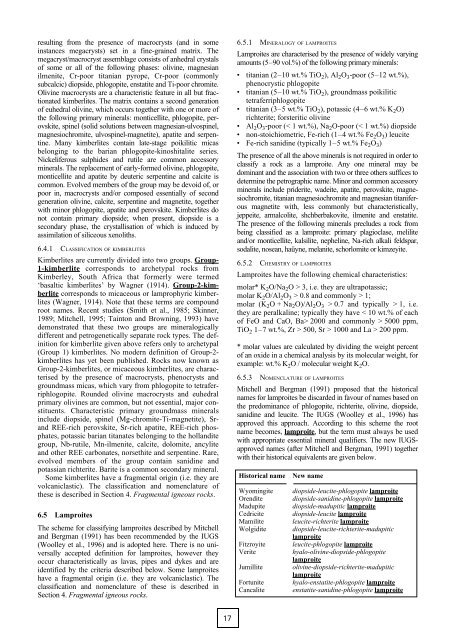Rock Classification Scheme (BGS).pdf - The Water, Sanitation and ...
Rock Classification Scheme (BGS).pdf - The Water, Sanitation and ...
Rock Classification Scheme (BGS).pdf - The Water, Sanitation and ...
You also want an ePaper? Increase the reach of your titles
YUMPU automatically turns print PDFs into web optimized ePapers that Google loves.
esulting from the presence of macrocrysts (<strong>and</strong> in someinstances megacrysts) set in a fine-grained matrix. <strong>The</strong>megacryst/macrocryst assemblage consists of anhedral crystalsof some or all of the following phases: olivine, magnesianilmenite, Cr-poor titanian pyrope, Cr-poor (commonlysubcalcic) diopside, phlogopite, enstatite <strong>and</strong> Ti-poor chromite.Olivine macrocrysts are a characteristic feature in all but fractionatedkimberlites. <strong>The</strong> matrix contains a second generationof euhedral olivine, which occurs together with one or more ofthe following primary minerals: monticellite, phlogopite, perovskite,spinel (solid solutions between magnesian-ulvospinel,magnesiochromite, ulvospinel-magnetite), apatite <strong>and</strong> serpentine.Many kimberlites contain late-stage poikilitic micasbelonging to the barian phlogopite-kinoshitalite series.Nickeliferous sulphides <strong>and</strong> rutile are common accessoryminerals. <strong>The</strong> replacement of early-formed olivine, phlogopite,monticellite <strong>and</strong> apatite by deuteric serpentine <strong>and</strong> calcite iscommon. Evolved members of the group may be devoid of, orpoor in, macrocrysts <strong>and</strong>/or composed essentially of secondgeneration olivine, calcite, serpentine <strong>and</strong> magnetite, togetherwith minor phlogopite, apatite <strong>and</strong> perovskite. Kimberlites donot contain primary diopside; when present, diopside is asecondary phase, the crystallisation of which is induced byassimilation of siliceous xenoliths.6.4.1 CLASSIFICATION OF KIMBERLITESKimberlites are currently divided into two groups. Group-1-kimberlite corresponds to archetypal rocks fromKimberley, South Africa that formerly were termed‘basaltic kimberlites’ by Wagner (1914). Group-2-kimberlitecorresponds to micaceous or lamprophyric kimberlites(Wagner, 1914). Note that these terms are compoundroot names. Recent studies (Smith et al., 1985; Skinner,1989; Mitchell, 1995; Tainton <strong>and</strong> Browning, 1993) havedemonstrated that these two groups are mineralogicallydifferent <strong>and</strong> petrogenetically separate rock types. <strong>The</strong> definitionfor kimberlite given above refers only to archetypal(Group 1) kimberlites. No modern definition of Group-2-kimberlites has yet been published. <strong>Rock</strong>s now known asGroup-2-kimberlites, or micaceous kimberlites, are characterisedby the presence of macrocrysts, phenocrysts <strong>and</strong>groundmass micas, which vary from phlogopite to tetraferriphlogopite.Rounded olivine macrocrysts <strong>and</strong> euhedralprimary olivines are common, but not essential, major constituents.Characteristic primary groundmass mineralsinclude diopside, spinel (Mg-chromite-Ti-magnetite), Sr<strong>and</strong>REE-rich perovskite, Sr-rich apatite, REE-rich phosphates,potassic barian titanates belonging to the holl<strong>and</strong>itegroup, Nb-rutile, Mn-ilmenite, calcite, dolomite, ancylite<strong>and</strong> other REE carbonates, norsethite <strong>and</strong> serpentine. Rare,evolved members of the group contain sanidine <strong>and</strong>potassian richterite. Barite is a common secondary mineral.Some kimberlites have a fragmental origin (i.e. they arevolcaniclastic). <strong>The</strong> classification <strong>and</strong> nomenclature ofthese is described in Section 4. Fragmental igneous rocks.6.5 Lamproites<strong>The</strong> scheme for classifying lamproites described by Mitchell<strong>and</strong> Bergman (1991) has been recommended by the IUGS(Woolley et al., 1996) <strong>and</strong> is adopted here. <strong>The</strong>re is no universallyaccepted definition for lamproites, however theyoccur characteristically as lavas, pipes <strong>and</strong> dykes <strong>and</strong> areidentified by the criteria described below. Some lamproiteshave a fragmental origin (i.e. they are volcaniclastic). <strong>The</strong>classification <strong>and</strong> nomenclature of these is described inSection 4. Fragmental igneous rocks.6.5.1 MINERALOGY OF LAMPROITESLamproites are characterised by the presence of widely varyingamounts (5–90 vol.%) of the following primary minerals:• titanian (2–10 wt.% TiO 2 ), Al 2 O 3 -poor (5–12 wt.%),phenocrystic phlogopite• titanian (5–10 wt.% TiO 2 ), groundmass poikilitictetraferriphlogopite• titanian (3–5 wt.% TiO 2 ), potassic (4–6 wt.% K 2 O)richterite; forsteritic olivine• Al 2 O 3 -poor (< 1 wt.%), Na 2 O-poor (< 1 wt.%) diopside• non-stoichiometric, Fe-rich (1–4 wt.% Fe 2 O 3 ) leucite• Fe-rich sanidine (typically 1–5 wt.% Fe 2 O 3 )<strong>The</strong> presence of all the above minerals is not required in order toclassify a rock as a lamproite. Any one mineral may bedominant <strong>and</strong> the association with two or three others suffices todetermine the petrographic name. Minor <strong>and</strong> common accessoryminerals include priderite, wadeite, apatite, perovskite, magnesiochromite,titanian magnesiochromite <strong>and</strong> magnesian titaniferousmagnetite with, less commonly but characteristically,jeppeite, armalcolite, shchberbakovite, ilmenite <strong>and</strong> enstatite.<strong>The</strong> presence of the following minerals precludes a rock frombeing classified as a lamproite: primary plagioclase, melilite<strong>and</strong>/or monticellite, kalsilite, nepheline, Na-rich alkali feldspar,sodalite, nosean, haüyne, melanite, schorlomite or kimzeyite.6.5.2 CHEMISTRY OF LAMPROITESLamproites have the following chemical characteristics:molar* K 2 O/Na 2 O > 3, i.e. they are ultrapotassic;molar K 2 O/Al 2 O 3 > 0.8 <strong>and</strong> commonly > 1;molar (K 2 O+Na 2 O)/Al 2 O 3 > 0.7 <strong>and</strong> typically > 1, i.e.they are peralkaline; typically they have < 10 wt.% of eachof FeO <strong>and</strong> CaO, Ba> 2000 <strong>and</strong> commonly > 5000 ppm,TiO 2 1–7 wt.%, Zr > 500, Sr > 1000 <strong>and</strong> La > 200 ppm.* molar values are calculated by dividing the weight percentof an oxide in a chemical analysis by its molecular weight, forexample: wt.% K 2 O / molecular weight K 2 O.6.5.3 NOMENCLATURE OF LAMPROITESMitchell <strong>and</strong> Bergman (1991) proposed that the historicalnames for lamproites be discarded in favour of names based onthe predominance of phlogopite, richterite, olivine, diopside,sanidine <strong>and</strong> leucite. <strong>The</strong> IUGS (Woolley et al., 1996) hasapproved this approach. According to this scheme the rootname becomes, lamproite, but the term must always be usedwith appropriate essential mineral qualifiers. <strong>The</strong> new IUGSapprovednames (after Mitchell <strong>and</strong> Bergman, 1991) togetherwith their historical equivalents are given below.Historical nameWyomingiteOrenditeMadupiteCedriciteMamiliteWolgiditeFitzroyiteVeriteJumilliteFortuniteCancaliteNew namediopside-leucite-phlogopite lamproitediopside-sanidine-phlogopite lamproitediopside-madupitic lamproitediopside-leucite lamproiteleucite-richterite lamproitediopside-leucite-richterite-madupiticlamproiteleucite-phlogopite lamproitehyalo-olivine-diopside-phlogopitelamproiteolivine-diopside-richterite-madupiticlamproitehyalo-enstatite-phlogopite lamproiteenstatite-sanidine-phlogopite lamproite17
















